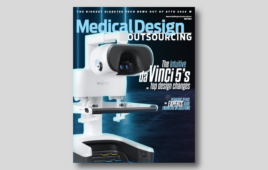
Marie Ottum, principal R&D engineer in TE Connectivity’s Advanced Technology Group [Photo courtesy of Marie Ottum]
Marie Ottum, principal R&D engineer in TE Connectivity’s Advanced Technology Group and global leader of the TE women’s networking group, is an expert on single-use endoscopes who was recently featured on MassDevice’s DeviceTalks Tuesdays.
Medical Design & Outsourcing caught up with Ottum to learn more about how and where she finds inspiration, innovation and creativity. (The following has been edited for space and clarity.)

TE Connectivity single-use bronchoscope [Photo courtesy of TE Connectivity]
“Cross-pollination can really ramp up your creativity. And it can also kind of break some ruts if you’ve got new teams of people you’re working with on occasion. We all get to know our teams and collaborate well with them, but it can be exciting to work with new people.”
“TE’s an enormous company. We have tens of thousands of employees around the globe, working in the energy sector, automotive, defense or, in my case, medical. So by paying attention to and networking with the other engineers in the company, I can also look to different types of products for inspiration. Maybe I’m working on a surgical product where it needs to be able to survive an autoclave 500 times so that it’s sterile and safe for use in the body, and I’m struggling with a material selection or something. I could also go talk to people who work in aerospace or even automotive. They may have similar harsh environment applications where they’ve taken drastically different approaches than some of our medical devices that I can use as inspiration to think about the problem in a different way. TE has a big engineering event in a different region of the world every year called TechCon, where all of the engineers can submit their work, and a small percentage gets selected to present tools or best practices or innovative ideas they’ve had. And then there are open forums afterward for collaboration. It’s a really great way to not only get new ideas, but also to meet new people that you might pull into future brainstorming sessions or reach out to for a fresh perspective.”
“I need natural light. In my home office, I’ve got windows looking out at flowers and trees. And I try to spend part of my day outside while I’m working. I find that that is very relaxing for me, and I do better work when I’m relaxed.”
“I use music for focus. I change the type of music I’m listening to during the day, depending on what I’m trying to do. I can’t explain it, but when I’m in a CAD system designing, listening to old-time country music works for me. That’s not what I listen to pretty much any other time. Willie Nelson, Johnny Cash, and the like. One of my. previous colleagues had a band that played this type of music and he used to occasionally have it playing at his desk. It made me laugh, but whenever he’d have it going, I would be able to get more into what I was doing from a design perspective. How strange is that? I don’t know, it works for me. My dad’s an engineer as well, and that was his type of music. I think a little part of me is channeling him.”
“I get inspiration from my children. I like to go to the schools and do science and STEM activities with the kids. We put together fun activities like figuring out how to get a little car to move from one end of the table to the other without touching it, an exercise in different types of energy — potential energy, kinetic energy — and different materials. Or how tall a structure can you build with uncooked spaghetti and tape, or can you light up LEDs using lemons or potatoes? The kids and their creative solutions are inspiring, and getting out into a different environment is inspiring. I always take other engineers with me, and before we go, I have us all do the activity together in our cafeteria. These little engineering challenges are things that we all know how to do, but we get competitive about who can do it in the craziest way or the most out-of-the-box way, and it’s loads of fun. We do less of this with COVID, but we’re still finding ways to put little challenges out there to get our brains flowing in different ways and to have a little bit of fun and lighten up a little bit.”
“I put a podcast on this week that led me to reconsider some designs I was working on: “People I (Mostly) Admire” from Freakonomics. There was one particular episode called “Leidy Klotz on Why the Best Solutions Involve Less — Not More” that challenges that idea that to improve any solution you have to add something. Rather, in many cases you can subtract to create better outcomes. I also listen to Harvard Business Review’s “Women at Work” podcast. Not for innovation inspiration necessarily, but because I have found that I can relate to some of the struggles and successes they discuss. I watch “How It’s Made” with my kids. My youngest, Jacob, is into fishing right now, and we watched one on fly fishing rods, which was followed by an episode on how they make micro-drill bits and then breakfast cereal. The variety is amazing, and the exposure and reminders of different manufacturing methods and design elements is useful.”




![A photo of the Medtronic GI Genius ColonPro polyp detection system flagging a potential sign of colon cancer during a colonoscopy. [Photo courtesy of Medtronic]](https://www.medicaldesignandoutsourcing.com/wp-content/uploads/2024/04/Medtronic-GI-Genius-doctors-268x170.jpg)